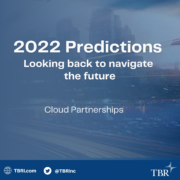Cloud partnerships prove even more important than expected in 2022
Coming into 2022, we expected partnerships to be important in cloud, but that was an understatement. From both vendor and partner sides, interest in strengthening cloud partnerships has been palpable.
The current macroeconomic uncertainty makes cloud partnerships an even more important factor in cloud growth heading into 2023. Cloud remains a focal point for most customer IT investments, but cloud partnerships can address the growing desire for solutions that are customized to customer requirements and can demonstrate cost-effectiveness.
Prediction No. 1: Partners enable growth and stickiness
Principal Analyst and Practice Manager Allan Krans: The cloud market has largely developed in a time of economic expansion. The growth that began in earnest in the aftermath of the 2008 recession has given the leading vendors and cloud market overall a very fertile economic environment. While the U.S. economy is still not technically in a recession, the environment does have a distinct negative tone.
Hiring has slowed for many of the largest technology vendors. Inflation levels not seen for decades are impacting the bottom lines of businesses across the board, including in the cloud space. These macroeconomic factors will have an impact, for both cloud vendors and their customer bases. IT spending growth could slow, and layoffs could mean smaller SaaS subscriptions upon renewal. And rising infrastructure and utility costs will force cloud providers to decide between increasing prices or seeing profitability levels decline.
It is in the face of all this looming economic uncertainty that the benefits of a partner ecosystem are shining. As vendors are reluctant to expand direct sales teams, partners can help throughout the sales cycle to cost-effectively contribute to revenue growth. Stickiness is even more critical in an uncertain environment, as high renewal rates are critical for both securing revenue and the profitability of the overall business. Many customers will be forced to look more carefully at cost in a tight economic environment, and having a partner to amplify the value of a cloud vendor’s solution can be a determining factor in renewal decisions.
Prediction No. 2: Value-add partners in software development and managed services become the focus in 2022
Allan: So far in 2022, TBR’s expectation that software development and managed service provider partners would be a focus has not only been confirmed, but the trend has been more pronounced than anticipated. Our prediction was primarily driven by the partner programs, which cover the thousands of smaller partners participating in the major cloud ecosystems.
On the software development side, marketplaces are the best litmus test for the activity of those smaller partners, and activity has been brisk during the year. Marketplace transactions are being mentioned as a growth driver by a number of ISVs, including Zscaler, CrowdStrike and Informatica. This also means revenue streams are growing for the marketplace providers, including Salesforce, Amazon Web Services (AWS), Microsoft and Google Cloud. Competition for ISV titles is getting even more heated, with Google Cloud reportedly cutting its revenue-sharing fee significantly during the year in order to sweeten the financial incentives for its software development partners.
Beyond the developments focused on smaller partners, some of the major names in IT have also illustrated the growing focus on software development during the year. Oracle’s cloud strategy had originally focused on an entirely “Red Stack” of the company’s own technology, but Oracle recently announced partnerships to make database offerings available on both Azure and AWS cloud platforms. Oracle will make its MySQL Heatwave cloud database available through the AWS platform.
Oracle will also make its fully managed database offerings running on Oracle Cloud Infrastructure (OCI) directly available from the Azure platform. This offering in particular preserves the performance and cost advantages Oracle claims for database and OCI offerings but broadens the availability through the partnership with Microsoft.
Prediction No. 3: Partner activities will be more important than traditional designations
Allan: The stress on traditional partner program designations continued in 2022. During the year we saw systems integrators packaging and selling their IP as a cloud subscription, a vastly different business for firms like PwC. Traditional reseller vendors like CDW are offering AWS managed services to clients. And even the cloud providers themselves are building out professional service capabilities as both a growth avenue and a value-add for clients.
Amid this business model fluidity, we saw greater flexibility being offered from cloud providers like AWS and Microsoft. AWS introduced a new Paths partner framework, featuring five dedicated tracks for partners — Software, Hardware, Training, Services and Distribution — each with its own set of resources and benefits.
AWS also began offering Partner Marketing Central, a self‐service portal available to partners, regardless of their dedicated path, for launching and managing marketing campaigns and educating workforces. Microsoft, for its part, renamed its partner program and refocused the designations not around the business model of the partners, but on the solution areas they achieve competency within.
Predictions is an annual TBR series examining market trends and business changes in key markets. 2022 covered segments included cloud, telecom, devices, data center, and services & digital.

 Technology Business Research, Inc.
Technology Business Research, Inc.
 Technology Business Research, Inc.
Technology Business Research, Inc.